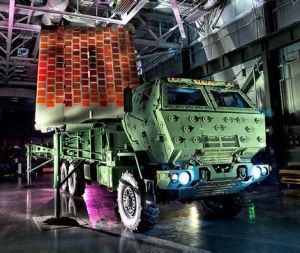By Mark Weiner
====
MEADS and Lockheed Martin officials said they could not release photos or videos of the test because of the classified nature, nor could they disclose the names of the NATO officials who witnessed the demonstration.
[T]he test in Central New York was among the last big milestones before a full missile intercept test for MEADS planned this fall at White Sands Missile Range in New Mexico.
In March, Congress approved spending $380 million to pay for the final year of MEADS development.
====

MEADS surveillance radar prototype
Washington:Military leaders from the Pentagon, Italy and Germany were in Central New York this week to witness a classified test of a missile defense system.
As part of the test, a small plane and a simulated tactical ballistic missile were detected and tracked by the Medium Extended Air Defense System, or MEADS, its developers said today.
MEADS, developed in part by Lockheed Martin with partners in Italy and Germany, was tested using radars placed at Lockheed's test range in Cazenovia and on its campus at Electronics Park in Salina.
Marty Coyne, business development director for MEADS International, said the test conducted Wednesday was a success by all measures.
MEADS and Lockheed Martin officials said they could not release photos or videos of the test because of the classified nature, nor could they disclose the names of the NATO officials who witnessed the demonstration.
"We had visitors from all three nations," Coyne said today. "By all accounts, all of the parties came out quite impressed with both the capability and maturity of those radar assets."
The MEADS 360-degree surveillance radar, developed at Lockheed's campus in Salina, was placed at a testing range in Cazenovia for the demonstration, Coyne said.
The radar in Cazenovia simultaneously tracked and relayed the location of the simulated missile and test aircraft that took off from Syracuse's Hancock International Airport to the MEADS battle manager.
In turn, the system cued a fire-control radar located more than 10 miles away in Salina to acquire and track the target aircraft, Coyne said. In the battlefield, an interceptor missile would have been fired to destroy the target.
Coyne said the test in Central New York was among the last big milestones before a full missile intercept test for MEADS planned this fall at White Sands Missile Range in New Mexico.
In March, Congress approved spending $380 million to pay for the final year of MEADS development.
The Pentagon says it has no intention to deploy MEADS, originally designed as a successor to the Patriot missile defense system, because of cost overruns and early development problems. The United States, Germany and Italy have spent a combined $4 billion on the program.
...
Pentagon officials have said they intend to "harvest" promising technologies developed as part of the MEADS project, including the 360-degree surveillance radar developed by Lockheed Martin engineers and technicians in Central New York.
Coyne said the purpose of Wednesday's test was to demonstrate the capabilities of MEADS. "All three nations are looking to harvest this investment in MEADS in future modernization plans," he said.
The MEADS project is the largest radar contract in the history of the Lockheed Martin facility at Electronics Park in Salina, which has about 1,900 employees. Lockheed is the major partner in the United States for MEADS International, a multinational joint venture headquartered in Orlando, Fla.
--
Sean Eagan
American Cold War Veterans, Inc.
| Web: | http://americancoldwarvets.org/ |
| Blog: | Cold War Veterans Blog |
| Email: | Sean.Eagan@gmail.com |
| Phone: | |
| Network: | My Fast Pitch! Profile |



No comments:
Post a Comment
Do you have something to say?